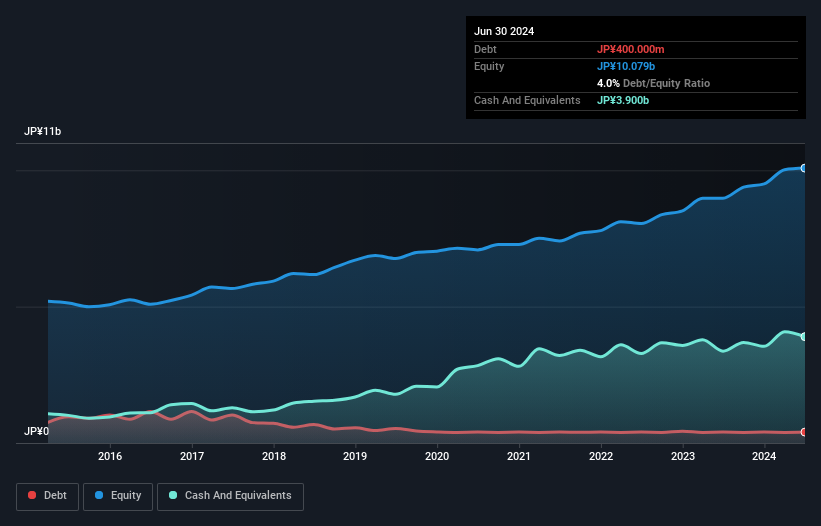These 4 Measures Indicate That Tacmina (TSE:6322) Is Using Debt Reasonably Well

David Iben put it well when he said, 'Volatility is not a risk we care about. What we care about is avoiding the permanent loss of capital.' So it seems the smart money knows that debt - which is usually involved in bankruptcies - is a very important factor, when you assess how risky a company is. As with many other companies Tacmina Corporation (TSE:6322) makes use of debt. But is this debt a concern to shareholders?
When Is Debt Dangerous?
Debt is a tool to help businesses grow, but if a business is incapable of paying off its lenders, then it exists at their mercy. If things get really bad, the lenders can take control of the business. While that is not too common, we often do see indebted companies permanently diluting shareholders because lenders force them to raise capital at a distressed price. By replacing dilution, though, debt can be an extremely good tool for businesses that need capital to invest in growth at high rates of return. The first step when considering a company's debt levels is to consider its cash and debt together.
View our latest analysis for Tacmina
How Much Debt Does Tacmina Carry?
The chart below, which you can click on for greater detail, shows that Tacmina had JP¥400.0m in debt in June 2024; about the same as the year before. But it also has JP¥3.90b in cash to offset that, meaning it has JP¥3.50b net cash.

How Strong Is Tacmina's Balance Sheet?
We can see from the most recent balance sheet that Tacmina had liabilities of JP¥3.35b falling due within a year, and liabilities of JP¥1.17b due beyond that. On the other hand, it had cash of JP¥3.90b and JP¥4.26b worth of receivables due within a year. So it actually has JP¥3.63b more liquid assets than total liabilities.
It's good to see that Tacmina has plenty of liquidity on its balance sheet, suggesting conservative management of liabilities. Due to its strong net asset position, it is not likely to face issues with its lenders. Succinctly put, Tacmina boasts net cash, so it's fair to say it does not have a heavy debt load!
The good news is that Tacmina has increased its EBIT by 7.1% over twelve months, which should ease any concerns about debt repayment. The balance sheet is clearly the area to focus on when you are analysing debt. But it is Tacmina's earnings that will influence how the balance sheet holds up in the future. So when considering debt, it's definitely worth looking at the earnings trend. Click here for an interactive snapshot.
Finally, while the tax-man may adore accounting profits, lenders only accept cold hard cash. While Tacmina has net cash on its balance sheet, it's still worth taking a look at its ability to convert earnings before interest and tax (EBIT) to free cash flow, to help us understand how quickly it is building (or eroding) that cash balance. Looking at the most recent three years, Tacmina recorded free cash flow of 41% of its EBIT, which is weaker than we'd expect. That's not great, when it comes to paying down debt.
Summing Up
While it is always sensible to investigate a company's debt, in this case Tacmina has JP¥3.50b in net cash and a decent-looking balance sheet. On top of that, it increased its EBIT by 7.1% in the last twelve months. So is Tacmina's debt a risk? It doesn't seem so to us. There's no doubt that we learn most about debt from the balance sheet. However, not all investment risk resides within the balance sheet - far from it. We've identified 1 warning sign with Tacmina , and understanding them should be part of your investment process.
If you're interested in investing in businesses that can grow profits without the burden of debt, then check out this free list of growing businesses that have net cash on the balance sheet.
Valuation is complex, but we're here to simplify it.
Discover if Tacmina might be undervalued or overvalued with our detailed analysis, featuring fair value estimates, potential risks, dividends, insider trades, and its financial condition.
Access Free AnalysisHave feedback on this article? Concerned about the content? Get in touch with us directly. Alternatively, email editorial-team (at) simplywallst.com.
This article by Simply Wall St is general in nature. We provide commentary based on historical data and analyst forecasts only using an unbiased methodology and our articles are not intended to be financial advice. It does not constitute a recommendation to buy or sell any stock, and does not take account of your objectives, or your financial situation. We aim to bring you long-term focused analysis driven by fundamental data. Note that our analysis may not factor in the latest price-sensitive company announcements or qualitative material. Simply Wall St has no position in any stocks mentioned.
About TSE:6322
Tacmina
Manufactures and sells precision pumps in Japan and internationally.
Flawless balance sheet established dividend payer.
Market Insights
Community Narratives




